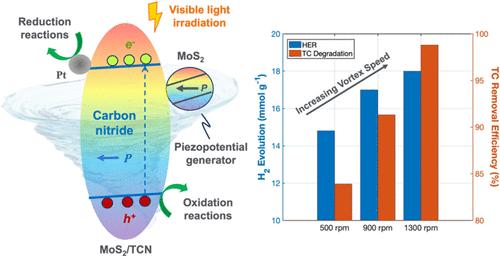MoS2/富碳氮化碳异质结构的流体机械和可见光驱动压电催化促进绿色能源生产和环境修复
IF 8.2
2区 材料科学
Q1 MATERIALS SCIENCE, MULTIDISCIPLINARY
引用次数: 0
摘要
二硫化钼(MoS2)/富碳氮化碳(TCN)异质结构是一种对流体机械能和可见光敏感的压电光催化剂,已被开发用于绿色能源生产和环境修复。优化后的MoS2/TCN异质结构在520 nm处的吸收边与TCN相同,但与传统的氮化碳相比有明显的红移。通过压电力显微镜的压电测量表明,在相同的施加电压下,MoS2/TCN异质结构产生的压电响应比TCN高得多。这种异质结构在可见光下对析氢反应(HER)和四环素(TC)降解的光催化性能都有很大的改善。此外,它的光催化活性进一步增强了涡诱导的流体运动。与TCN相比,优化后的MoS2/TCN异质结构的压光催化活性在15 min和60 min内将HER率从1.8提高到3.62 mmol g-1 h-1,将TC降解率从57.8%提高到85.1%,从73.2提高到98.8%。二硫化钼纳米片作为压电发生器,由流体流动触发,产生宏观的压电势,有助于在TCN表面收集可见光产生的电子和空穴,以提高催化活性。这项工作强调了流体流动对废水排放至关重要的剪切力,压电放大了MoS2/TCN异质结构的光催化效率。本文章由计算机程序翻译,如有差异,请以英文原文为准。

Fluid Mechanical and Visible-Light-Driven Piezophotocatalysis in MoS2/Carbon-Rich Carbon Nitride Heterostructures for Enhanced Green Energy Production and Environmental Remediation
Molybdenum disulfide (MoS2)/carbon-rich carbon nitride (TCN) heterostructure, a piezophotocatalyst sensitive to fluid mechanical energy and visible light, has been developed for green energy production and environmental remediation. The optimized MoS2/TCN heterostructure exhibits an absorption edge at 520 nm, identical to that of TCN but significantly red-shifted compared with conventional carbon nitride. Piezopotential measurements via piezoelectric force microscopy demonstrate that the MoS2/TCN heterostructure generates a much higher piezopotential response than TCN under the same applied voltage. This heterostructure exhibits substantial improvements in photocatalytic performance for both the hydrogen evolution reaction (HER) and the degradation of tetracycline (TC) under visible light. Additionally, its photocatalytic activity is further enhanced by vortex-induced fluid motion. Compared to TCN, the piezophotocatalytic activity of the optimized MoS2/TCN heterostructure increases the HER rate from 1.8 to 3.62 mmol g–1 h–1 and the TC degradation rates from 57.8 to 85.1% and 73.2 to 98.8% in 15 and 60 min, respectively. MoS2 nanosheets act as piezoelectric generators, triggered by fluid flow, to induce a macroscopic piezopotential, aiding in the collection of visible-light-generated electrons and holes on the TCN surface to enhance catalytic activity. This work highlights that the shearing forces from fluid flow, essential for wastewater discharge, piezoelectrically amplify the photocatalytic efficiency of the MoS2/TCN heterostructure.
求助全文
通过发布文献求助,成功后即可免费获取论文全文。
去求助
来源期刊

ACS Applied Materials & Interfaces
工程技术-材料科学:综合
CiteScore
16.00
自引率
6.30%
发文量
4978
审稿时长
1.8 months
期刊介绍:
ACS Applied Materials & Interfaces is a leading interdisciplinary journal that brings together chemists, engineers, physicists, and biologists to explore the development and utilization of newly-discovered materials and interfacial processes for specific applications. Our journal has experienced remarkable growth since its establishment in 2009, both in terms of the number of articles published and the impact of the research showcased. We are proud to foster a truly global community, with the majority of published articles originating from outside the United States, reflecting the rapid growth of applied research worldwide.
 求助内容:
求助内容: 应助结果提醒方式:
应助结果提醒方式:


